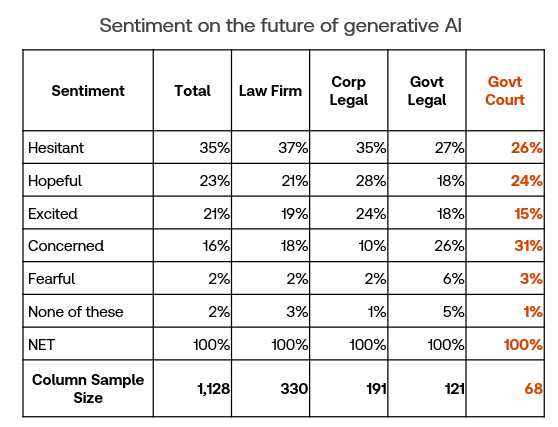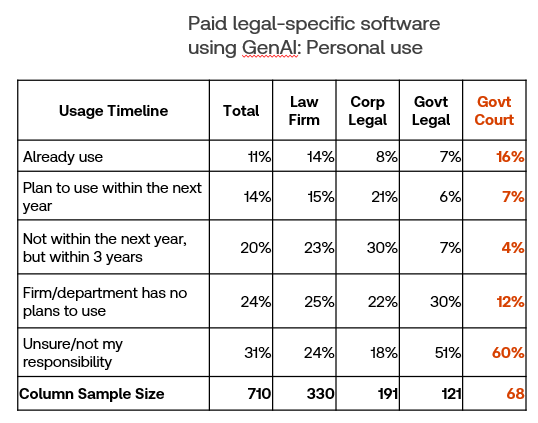Many judges and court personnel see a future legal system that uses GenAI, but they don’t know where courts fit into the picture, according to a recent survey
In many legal jurisdictions across the world, jurists are beginning to pay more attention to the influence that generative artificial intelligence (GenAI) has on court procedures and rulings. In the United States, for instance, not only was AI a central component of U.S. Supreme Court Chief Justice John Roberts’ 2023 year-end report, judges at both the federal and state court level have begun exploring what the rise of GenAI may mean in practice in their courtrooms. Similar explorations have played out in the United Kingdom, Australia, and elsewhere.
Even so, not all courts view GenAI as the future. Compared to others in the legal profession, judges and other court personnel are more cautious in their feelings about the use of GenAI in the workplace, as the recent 2024 Generative AI in Professional Services report from the Thomson Reuters Institute revealed. The result is that, although many judges agree that GenAI can and should be used in legal work, the rate of adoption of these technologies among courts is much lower than in the rest of the legal sphere.
For their part, many judges seem to be waiting for the technology to overcome some technological hurdles before they feel comfortable enough to proceed. “I recognize the power and possibilities in generative AI,” says one Australian judge. “But depending on how it is developed, deployed, and perceived, there are significant risks.”
Unfortunately, this ultimately may mean that many courts risk being left behind and even being eclipsed by the parties appearing before them in their courtrooms in terms of both understanding and utilizing this new technology.
Still waiting
While many in the legal industry have largely approached GenAI with positive perceptions, those feelings do not necessarily extend to the judiciary. Despite more than three-quarters of court respondents to the GenAI in Professional Services survey saying that they believe GenAI can be applied to legal work, and nearly half saying it should be applied to legal work, court personnel offered more negative sentiments about this change than their legal peers.

In fact, while the neutral option hesitant was the most common sentiment among law firm and corporate legal department respondents, followed by the more positive hopeful and excited, the most common sentiment among court personnel was concerned.
In fact, these court personnel went on to cite a number of different reasons as to why they felt this way. Issues around the technology’s accuracy and security was mentioned by parties across the legal spectrum. However, there was one reason cited by a higher proportion of court personnel specifically: concerns about AI replacing human reasoning and decision-making.
“The court relies on facts provided by a party through lived experiences. It would be challenging to pivot to the use of a tool that is used as a form of translation,” noted one Canadian court administrator who said they were concerned. “Oftentimes, how someone writes and expresses themselves is important and helps paint an accurate landscape of the environment.”
As a result, it may not be surprising that court personnel are using GenAI tools at a lower rate than others within the legal industry. What may be interesting, however, is that courts are not necessarily against the tools either — many are simply unsure how GenAI could ultimately fit into their daily work.
For instance, when asked whether they use legal-specific tools that utilize GenAI, such as common legal research or document review tools, just 27% of court respondents said they either use them now or plan to use them within the next three years. At the same time, only 12% said they had no plans to use them at all, with the remainder answering that they were unsure, or that decisions on GenAI use was not their responsibility.

Finding the use case
As the abovementioned responses have shown, it’s not that courts are against GenAI, it’s that they are still figuring out where the technology fits into the modern court system.
The small number of courts that have used GenAI reported having done so for a variety of different reasons, most commonly including legal research, brief and memo drafting, document review, and document summarization. Those courts that have explored these use cases see the potential, while also noting some of the potential risks as well.
“I have used ChatGPT and other AI programs, and it saves time and levels the playing field for certain tasks and professions, but [it’s] also a bit dangerous in a sense that if it gets censored, it will inevitably be biased,” said one US judge. “But for computing and translating data, I think it is amazing.”
Still, many jurists and court professionals have not gotten to this level of sophistication with the tool, and this could in part be due to the lack of policies and procedures, as well as training, around GenAI at the court level.
When asked whether their workplace had a GenAI use policy, just 9% of court personnel answered affirmatively, the lowest of any type of professional services personnel surveyed. (Similarly, 31% answered that they don’t know, the highest of any type of personnel surveyed.) Additionally, just 18% said they had received any training around GenAI, which does put courts in line with law firms in this regard but remains a low figure compared to the business world at large.
These sentiments were reflected in what court personnel had to say about GenAI in general in the survey, in which many were left without strong opinions one way or the other due to a lack of information. As one Australian judicial assistant noted: “I don’t know too much about the implications of this to my job, and while there appears to be both pros and cons to this topic, there has been limited information communication in the context of our work.”
For judges and court systems eyeing GenAI then, the immediate first step should be education around the technology’s potential, as well as its proper and ethical use. GenAI is set to have a major impact on the legal industry of the future, with law firms and legal organizations of all shapes and sizes already exploring its use. It will be incumbent on courts to keep up with that pace, in order to both maintain an efficient court, as well as to properly analyze GenAI use among parties appearing before tomorrow’s judges.







